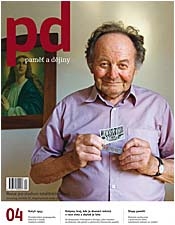We kindly inform you that, as long as the subject affiliation of our 300.000+ articles is in progress, you might get unsufficient or no results on your third level or second level search. In this case, please broaden your search criteria.


An interview with the young french writer Laurent Binet. He spoke about the czechoslovac history, a dialogue with the reader, and about the heroism of Jozef Gabčík and Jan Kubiš.
More...
Did Germany participate in the Katyn massacre? Was the murder of Polish officers coordinated with the Nazi’s repressive AB-Aktion operation? To what extent are similar stories true? Are they supported by archive documents and contemporary testimony? This study by the Polish historian Witold Wasilewski offers an extensive evaluation of the facts surrounding Soviet-German cooperation in Poland. By analysing the data that ensues from this work, it seems most likely that the Nazis had no idea about the Katyn murders until April 1943, and that they did not provide any cover or support for the NKVD’s actions despite previous mutual cooperation.
More...
In the course of the First Indochina War (1946–1954), more than 2,000 former Czechoslovak citizens fought in the uniform of the French Foreign Legion. Around 500 of them died on the battlefield in Southeast Asia. Roughly 115 Czechoslovaks ended up being captured by the Vietnamese in the course of the conflict. At least 17 more deserted to side with the Viet Minh. Ladislav Kudrna describes the living conditions in the detention camps as well as the fate of Czechoslovak prisoners and deserters during and after the war, and upon their release from captivity.
More...
An interview with Semyon Vilensky - a former prisoner of Kolyma.
More...
History described through fotographic portraits of victims of totalitarian regimes. The author of these pictures won the Czech Press Photo award with this reportage.
More...


The liquidation of Poland’s national elite in the uniforms of the Polish Army is a story with many twists and turns, both in the actual disclosure of this appalling crime and in the context of international politics at the time, as well as during the subsequent Cold War era. Publicising the discovery of mass graves in April 1943 could not have been done without the participation of certain personalities from the Protectorate of Bohemia and Moravia or without a mass propaganda campaign in the Protectorate’s press and radio broadcasts. Thanks to some partial studies, the fate of the pathologist Professor František Hájek and the writer František Kožík, who were confronted directly with the situation in Katyn Forest, is relatively well known. Both these witnesses to the exhumations in the forest were still forced to explain their presence there long after the war, and their “transgression” stayed with them till the end of their lives.
More...
The article contains book reviews. The review authors and titles of reviewed book are listed below in the original language. Cholínský, Jan: Dagmar ŠIMKOVÁ: Byly jsme tam taky. Vydala Monika Elšíková, Praha 2010, 163 s. Hanzlík, Jan:Jiří ŠULC: Mosty do Tel Avivu, Knižní klub, Praha 2010, 557 s. Tichý, Martin: Sametová revoluce v Ústí nad Labem. Svědectví studentů po dvaceti letech, Editor Jaroslav Rokoský, Filozofická fakulta Univerzity J. E. Purkyně, Ústí nad Labem 2009, 152 s. Kudělková, Jana: Jan HLACH: Požár aneb pět povídek z padesátých let a jeden sen, Ilustrace Vojtěch Vojtěch, PRAAM, Písek 2010, 72 s. Kudrna, Ladislav: Laurent BINET: HHhH, Překlad Michala Marková, Argo, Praha 2010, 346 s.
More...


The arrest and trial of founding officers of State Security (StB) is an important chapter in the history of the Czechoslovak security services. Karel Černý was also one of those arrested. The staffing “architect” of the StB was tried as part of the Osvald Závodský group. Černý was transformed from a person who actively participated in the construction of the new security apparatus (particularly State Security) after May 1945 into a “detested and despised enemy” of the Communist Party of Czechoslovakia (KSČ). In a manner similar to more famous cases, the KSČ also rewarded him for his “services” with a jail sentence lasting several years. Naturally, it is necessary to add that the convict wholly deserved to serve his sentence.
More...
One of the most typical and obvious activities of the anti-communist “third” resistance was the work carried out by couriers (“agent-couriers” in State Security terminology). These people crossed the borders between the free and unfree world in order to fulfil a whole range of dangerous tasks, particularly tasks connected with intelligence gathering. They were people who had various motives for working with Western intelligence services (besides patriotic reasons, they could also have had material incentives). Among the hundreds of people involved in this activity, we can find the names of two young men, Rudolf Fuksa and Jiří Hejna, who paid the highest possible price for their decision to take a stand against communist power. Their first mission as couriers was also to be their last.
More...